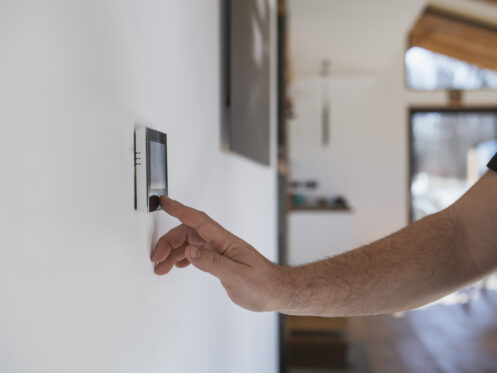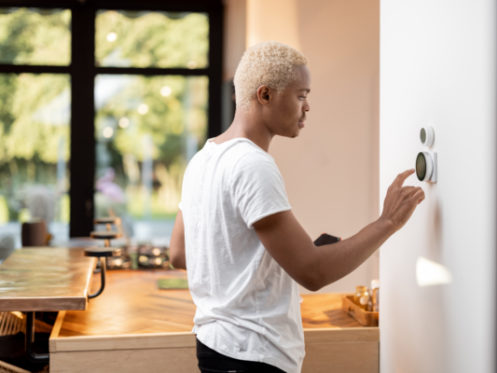A smart thermostat is an advanced temperature control device that uses connectivity, intelligent algorithms, and advanced sensors to optimize and manage the heating, ventilation, and air conditioning (HVAC) systems in a home or building. Unlike traditional thermostats requiring manual adjustment, smart thermostats offer automation, remote accessibility, and additional features that enhance energy efficiency, convenience, and comfort. There are many benefits of having a smart thermostat.
1. Intelligent Temperature Control
Smart thermostats use advanced sensors and learning algorithms to optimize temperature control. They use an algorithm that allows them to adapt to your behavior patterns, preferences, and occupancy schedule to create personalized temperature schedules. This intelligent temperature control minimizes energy consumption, reduces utility bills, and creates a reliably comfortable environment.
2. Occupancy Detection
Many smart thermostats have occupancy sensors that detect whether a room is occupied or empty. When the sensors detect no presence, the thermostat can automatically adjust the temperature to an energy-saving mode.
3. Weather Integration
Some smart thermostats integrate with weather forecasting services to receive real-time weather information. Therefore, the thermostat can adjust the temperature settings according to the projected external temperature and humidity levels, ensuring optimal comfort while minimizing energy usage.
4. Energy Usage Reports
Many smart thermostats provide detailed energy usage reports, allowing you to monitor your energy consumption patterns. These reports provide insights into energy usage trends, peak consumption times, and potential areas for improvement. By understanding your energy consumption patterns, you can make informed decisions to reduce waste, adjust temperature schedules, and optimize energy efficiency.
5. Remote Access and Control
Smart thermostats offer remote accessibility through mobile applications. A mobile app allows you to adjust your home’s temperature settings from anywhere. If you are away longer than expected, you can remotely adjust the temperature to save energy. Additionally, you can pre-cool or pre-heat your home before you return.
6. Compatibility With Smart Home Platforms
Smart thermostats are often compatible with popular innovative home platforms like Apple HomeKit, and Samsung SmartThings. These platforms act as a central hub for managing and controlling various smart devices in the home. This way, smart thermostats can communicate and coordinate with other connected devices by integrating with these platforms, expanding their functionality and interoperability.
7. Communication Protocols
Smart thermostats support communication protocols such as Wi-Fi, Zigbee, or Z-Wave. These protocols allow the thermostat to exchange information with other compatible smart devices in the home. For example, a smart thermostat can communicate with smart lighting, occupancy, or window sensors to optimize energy efficiency and comfort levels.
8. Voice Control
Smart thermostats can integrate with voice assistants like Amazon Alexa or Google Assistant. This integration allows you to control the thermostat using voice commands. You can adjust temperature settings, change modes, or check the current temperature simply by speaking voice commands to your preferred voice assistant. In turn, voice control integration enhances the ease and convenience of managing the thermostat within the smart home environment.
9. Web Interfaces
In addition to mobile applications, smart thermostats often have web interfaces that are accessible through internet browsers. This allows you to access and control your thermostat using a computer or laptop with an internet connection. Furthermore, web interfaces offer similar functionality to mobile apps, enabling users to remotely adjust temperature settings, view energy usage reports, and access advanced features. This feature is handy when you’re away from your phone or when you want to engage in a more thorough study of your home’s energy habits.
10. Geofencing
Some smart thermostats integrate geofencing technology, which uses your smartphone’s location to adjust temperature settings automatically. The thermostat can detect when you are leaving or approaching the area by setting up a virtual boundary around the home.
When you leave the geofenced area, the thermostat can adjust the temperature to an energy-saving mode. Conversely, when you enter the geofenced area, the thermostat can adjust the temperature comfortably.
11. Customized Temperature Schedules
Smart thermostats can create customized temperature schedules tailored to your preferences and daily routines. You can set different temperature settings for different times of the day, such as warmer mornings and cooler nights. If you know that you’re going to be away after work all week or gone during the day all weekend, you can use this information to further adjust your heating and cooling schedule. This level of customization ensures that your home is always at the desired temperature when you need it.
12. Individual Room Temperature Control and Zoning
Some smart thermostats support zoning capabilities, allowing you to control the temperature of individual rooms or zones in your home separately. This is particularly useful if you have multiple floors, large open spaces, or areas that require different temperature settings.
People who work from home, for example, often use zones for heating or cooling. If you know that you’re going to be in one area of the house for eight hours a day, you can set your system to heat or cool only that area while the rest of this house is in power-save mode.
13. Personalized Settings
Smart thermostats often provide the ability to create personalized settings for different rooms and areas of the home. Each area can have its temperature and humidity controlled separately. This is especially useful for people who, for example, are musical instrument or gaming enthusiasts. A powerful gaming setup will run hot and will require a cooler room while musical instruments are delicately crafted and have specific heat and humidity requirements.
14. Intuitive and User-friendly Interface
Smart thermostats provide a straightforward and easily understandable way to adjust the temperature settings in your home. Whether it’s a physical touch screen on the thermostat itself or a user-friendly mobile app, the interface allows you to make temperature adjustments effortlessly.
Smart thermostats with touchscreens generally display temperature information, current settings, and other relevant details in an appealing way. This visual feedback enhances the user experience and allows quick and precise temperature adjustments.
15. Easy Installation Process
Thanks to user-friendly installation procedures, installing a smart thermostat can be simple and straightforward. While you’ll definitely want to enlist a professional from Buehler Air Conditioning & Plumbing to install your new smart thermostat, most smart thermostats are created to work with existing HVAC systems, so they generally do not require you to change much about your existing setup. We generally don’t have to rewire anything or alter your walls, ceilings, or floors in any way to install a smart thermostat, so the installation won’t interrupt your busy schedule.
When you rely on the pros at Buehler Air Conditioning & Plumbing, you can benefit from our decades of experience in heating and AC installation, repair, and maintenance services. We promise a seamless transition to a smart thermostat, maximizing energy efficiency, comfort, and the overall performance of your HVAC system. We also offer air duct sealing and cleaning as well as air quality services. Contact us in Jacksonville, Florida to schedule your smart thermostat installation, and take the first step toward a smarter, more efficient home.



